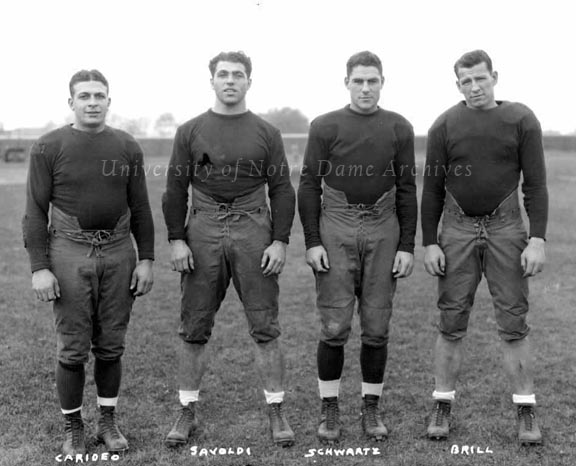
The student population at Notre Dame has always consisted of religions and denominations other than Catholic, including Jewish. Statistics of ethnic and religious backgrounds of Notre Dame students have not always been maintained, so exact numbers and percentages over the years are difficult to ascertain.
In 1878, Scholastic reported that the few Jewish students at Notre Dame celebrated Pasch: “It was remarked that all, even the youngest, kept a strict fast on the eve. They had recreation the the festival itself, and a fine day to enjoy it” [Scholastic, 04/2/1878, page 554]. In 1933, Scholastic reported that there were thirty-four Jewish students at Notre Dame out of 2547 total students [Scholastic, 10/20/1933, page 8].

Back row: Patrick E. Reardon, Angus D. McDonald, Trainer Housler, Thomas J. O’Hara, and William A. Fagan
Middle row: John (Jack) Mullen, Frank Hanley, Thomas T. Cavanaugh, Francis Lyons, Jacob Rosenthal, Frederick J. Schillo, John C. Murphy
Front row: Charles Moritz, Robert Emmett Brown, Michael T. Daly, Frank E. Hering, William C. “Vic” Kegler
The University Presidents Letters Collection contains much correspondence between parents of students at Notre Dame and the University Administration. Among those letters are a handful from Jewish parents inquiring about Notre Dame’s policy of attending Catholic religious services. In 1905, University President Andrew Morrissey responded that while students are required to attend Catholic services, they are not obliged to participate.
Jacob Rosenthal (pictured above) may have been Notre Dame’s first Jewish football player. The University Presidents’ Letters contain a number of letters from Rosenthal, his father Samuel, and his brother (possibly Moses, who also attended Notre Dame). We learn from Rosenthal that after graduating from Notre Dame, he attended medical school at the University of Pennsylvania and later worked for Catholic and Jewish hospitals.
Unfortunately, levels of discrimination and harassment are often inevitable when peoples of different cultures and religions coexist. In 1903, Mr. Bromberg removed his sons George and Louis from Notre Dame after allegations of mistreatment because of their Jewish faith [UPEL 106/16].
Athletic Director, Football and Track Coach Knute Rockne, a Norwegian Protestant who later converted to Catholicism, “had many Jewish friends” and “was a Judeophile, often speaking before Jewish groups and for Jewish causes, and also recruiting Jewish players for the Fighting Irish.” Among his athletes with Jewish backgrounds were Clarence Kaplan, Abie Zos, Norm Herwit, and Marchmont (Marchy) Schwartz. “As the master coach always said, not all Fighting Irish hailed from Ireland.” [Sperber, pages 299, 415, 561].

The first known Notre Dame graduate to become a Rabbi was Albert Plotkin.* Plotkin graduated in 1942 and continued his studies at the Hebrew Union College in Cincinnati, where he was ordained. Throughout Plotkin’s career, he became known for promoting interfaith dialog and understanding.

Professor Frank O’Malley (left) and Rabbi Albert Plotkin (right)
Plotkin credits his education at Notre Dame for instilling students with “a feeling that religion must become part and parcel of one’s entire being. It cannot be put away in a small corner and opened up once a week and then closed. It must become a way of life and a way of thinking which inspires one to feel one’s moral responsibility to one’s community. Going to a Catholic University made me rethink my own faith — the power it must play and the function it must use in my own life.” He continued, “I shared in exchange of ideas, of faith and of knowledge which was important to my inner security and to my understanding of my fellow Catholics. I learned to appreciate many of the profound qualities of their faith, and an understanding of their heritage and the realization of the bridge between Judaism and Christianity” [Plotkin, Notre Dame, Winter 1961, pages 4-5, 18].
* Updated 12/19/2016: Digitizing the Commencement programs has uncovered a few men who were already Rabbis at the time their graduate degrees were conferred: Rabbi Philip Shraga Greenstein (MA 1930), Rabbi Maurice Noah Stiskin (MA 1932), and Rabbi Hyman Jacob Coehn (MS 1943).
Sources:
PNDP 05-Je-01
PNDP 83-Nd-3s – “What Notre Dame Means to Me…” by Rabbi Albert Plotkin, Notre Dame, Winter 1961, pages 4-5, 18
UPEL 71/01
UPEL 93/09
UPEL 106/16
UPEL – Rosenthal correspondence
Scholastic
Shake down the Thunder by Murray Sperber
GBBY 81G/02
GBBY 81F/0491
GNDM 1298
